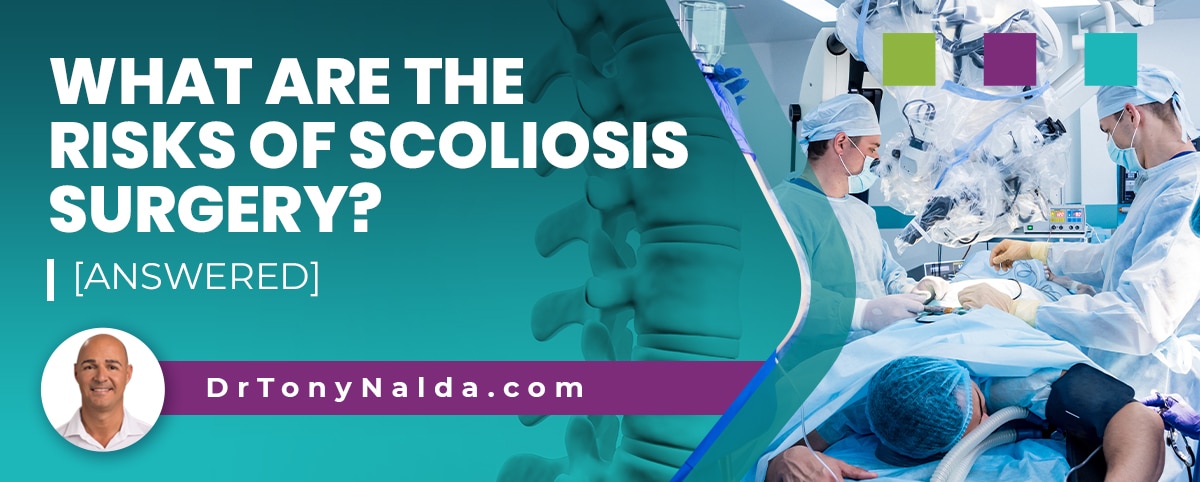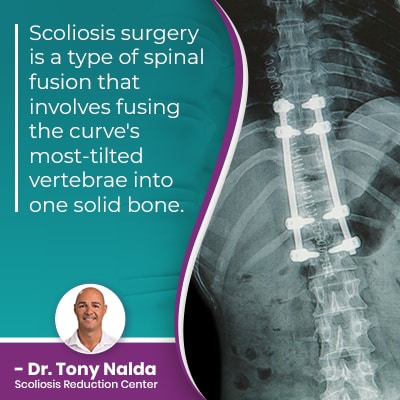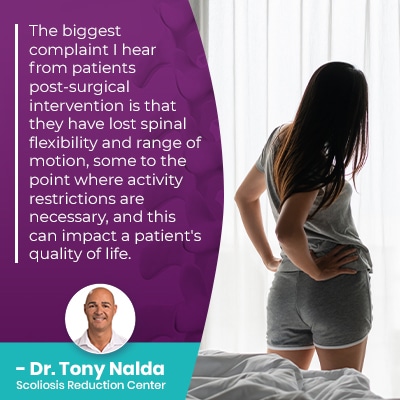What Are The Risks Of Scoliosis Surgery? [ANSWERED]

The risks of scoliosis can be serious, so should be considered carefully, and the reality is that not all cases of scoliosis require surgery. Different treatment approaches affect long-term spinal health and function in different ways, so I want patients to be fully educated on all treatment options available to them, including non-surgical treatment options.
The risks of scoliosis surgery include risks associated with the procedure itself, and risks involving how spinal fusion can disrupt long-term spinal health and function. Spinal fusion surgery can cause a noticeable loss in spinal flexibility and range of motion that can disrupt overall quality of life.
Let's explore the risks of spinal fusion surgery by first discussing the main differences between a surgical and a non-surgical treatment response.
Table of Contents
Scoliosis Treatment Approaches: Traditional vs Conservative
Scoliosis involves the development of an unnatural sideways spinal curve that also rotates, making it a complex 3-dimensional condition.
In addition, scoliosis is progressive, meaning it has it in its nature to worsen over time, and this means that where a scoliosis is at the time of diagnosis isn't indicative of where it will stay; only proactive treatment can work towards counteracting the condition's progressive nature.
When it comes to being diagnosed with scoliosis, the most important decision to be made is how to treat it moving forward.
Although as a progressive condition, scoliosis isn't curable, but it can be highly treatable, and there are different treatment approaches for patients to consider.
The two main scoliosis treatment approaches are traditional and conservative. Traditional scoliosis treatment was the dominant choice for many years, and this approach is commonly described as reactive because it does little to work towards preventing progression, and is more so focus on responding when/if conditions progress into the severe classification.
Conservative treatment offers a proactive approach and response by starting treatment as close to the time of diagnosis as possible, in the hopes of preventing progression, escalating symptoms, and the need for invasive surgical procedures in the future.
Traditional treatment commonly funnels patients towards spinal fusion surgery, so let's take a look at the risks associated with the procedure itself, and how the surgery can affect long-term spinal health related signs and function.
Spinal Fusion Surgery
 Scoliosis surgery is a type of spinal fusion that involves fusing the curve's most-tilted vertebrae into one solid bone.
Scoliosis surgery is a type of spinal fusion that involves fusing the curve's most-tilted vertebrae into one solid bone.
The spine consists of vertebrae (bones) that are stacked on top of one another in a straight and neutral alignment, but as scoliosis develops, some vertebral bodies are becoming unnaturally tilted, shifting their position and causing them to become misaligned with the rest of the spine, and a misaligned spine can cause a number of issues.
Spinal fusion has the goal of stopping progression; fusing the curve's most-tilted vertebrae into one solid bone, and adding rods that are attached with pedicle screws to hold the spine in place, can prevent those vertebrae from becoming more tilted over time.
Scoliosis only gets more complex to treat as the spine gets more rigid the more it progresses, making it less responsive to treatment and more complex to treat.
When it comes to the main risks of surgical intervention, I like to divide them into two categories: risks associated with the procedure itself, and those associated with how long-term spinal health is affected.
I do feel it's important to say that no two patients will respond to surgery in the exact same way as each spinal surgery case is unique, just as no two cases of scoliosis are the same, but some common scoliosis surgery side effects that involve the procedure itself can include:
- Neurological damage post surgery (nerve damage)
- Excessive blood loss
- Adverse reaction to hardware used
- Surgical site infections
While the short-term risks of spinal fusion can be serious, what I really want patients to be aware of are the long-term risks of spinal fusion surgery because these are what can shape a patient's quality of life.
Some long-term potential risks associated with spinal fusion can include:
- Increased pain at the fusion site
- Hardware malfunction over time
- A noticeable loss in spinal flexibility and range of motion
- A spine that's weaker and more vulnerable to injury
So the risks of scoliosis surgery don't just involve the procedure itself, but also how the health of the spine is affected because those effects are permanent.
A fused spine is contrary to its movement based design and doesn't just impact the spine, but also its surrounding muscles, and increased pain at the fusion site can be expected as the spine can be excessively rigid and painful, as can the muscles that surround the fused portion.
If a rod cracks or breaks or a screw comes loose, the only recourse is more surgery because once the spine is fused, it's fused for life, and hardware attached is permanent.
The biggest complaint I hear from patients post surgical intervention is that they have lost spinal flexibility and range of motion, some to the point where activity restrictions are necessary, and this can impact a patient's quality of life.
In addition, a fused spine will never be as strong and will be more vulnerable to injury, and this knowledge can also have a psychological impact that shouldn't be discounted.
It's also important to note that if the procedure doesn't work, or more surgeries are needed, the associated risks only increase with age and with each subsequent procedure.
Conservative Non-Surgical Scoliosis Treatment
 Conservative non-surgical procedures that address scoliosis on every level is what patient's of the Scoliosis Reduction Center benefit from.
Conservative non-surgical procedures that address scoliosis on every level is what patient's of the Scoliosis Reduction Center benefit from.
Conservative treatment acknowledges that scoliosis only gets more complex to treat the more severe it gets, so proactive efforts are made to prevent cases from even progressing to the point of causing noticeable symptoms.
While there are never treatment guarantees, it's far more effective to proactively work towards preventing progression and increasing condition effects, than it is to attempt to work towards reversing them once they're established.
Non-surgical scoliosis treatment is known as conservative treatment, but is also commonly referred to as chiropractic-centered and/or functional treatment, and this is because its goal is to preserve as much natural strength and spinal function as possible, so it's more aligned with the spine's natural movement-based design.
Conservative treatment is less invasive, costly, and has far fewer risks than those associated with spinal fusion surgery.
First and foremost, as a structural spinal condition, scoliosis has to be primarily impacted on a structural level, and this is worked towards through condition-specific chiropractic care that combines a series of techniques and manual adjustments to adjust the position of the most-tilted vertebrae at the curve's apex; their position can be adjusted so they are better aligned with the rest of the spine.
Once I see structural results, I can adjust the focus to increasing core strength as this can mean the spine is receiving optimal support and stabilization from its surrounding muscles; this can be achieved through the combination of physical therapy and scoliosis-specific exercises (SSEs) that can help increase muscle strength and flexibility, address any related muscle imbalance, improve posture, and stimulate certain areas of the brain for improved brain-body communication.
The final and ongoing phase of treatment is rehabilitation, and this can involve continued chiropractic care, and the prescription of a series of home exercises to further stabilize and heal the spine for long-term sustainable treatment results.
While scoliosis surgery still has a place in scoliosis treatment, conservative treatment has proven results that don't carry risks involving blood clots, wound infection, pulmonary embolism, chronic pain, deep venous thrombosis, surgical site infection, delayed infection, blood transfusion, peripheral nerve deficit, and needing repeat surgery.
Conclusion
Just as every surgical procedure comes with its share of risks, so too does scoliosis surgery, but because the brain and spinal cord work in tandem to form the body's central nervous system, spinal surgeries can carry some particularly serious potential risks, side effects, and surgical complications.
So what scoliosis patients need to be aware of is that spinal surgery is risky, including spine surgery used to address scoliosis, and if a spinal cord injury develops, this can involve nerve damage, and many cases of nerve damage are irreversible.
Spinal deformities addressed with surgery often involve a bone graft and the removal of intervertebral discs, and this type of surgical correction can come with a price; even when/if a spinal fusion successfully stops a condition from progressing, it can cost the spine in terms of its long-term strength, health, and function, and many patients are disappointed by the effects of living with a fused spine.
Scoliosis surgery is an invasive procedure that isn't always necessary, and for those wanting to forgo a surgical recommendation, or who simply want to try a safer approach to addressing scoliosis curve progression, curvature correction is possible through a less-invasive conservative treatment approach.
Here at the Center, my patients experience significant curvature reductions that allow them to maintain a normal active range of activities with few, if any, potential complications.
Dr. Tony Nalda
DOCTOR OF CHIROPRACTIC
After receiving an undergraduate degree in psychology and his Doctorate of Chiropractic from Life University, Dr. Nalda settled in Celebration, Florida and proceeded to build one of Central Florida’s most successful chiropractic clinics.
His experience with patients suffering from scoliosis, and the confusion and frustration they faced, led him to seek a specialty in scoliosis care. In 2006 he completed his Intensive Care Certification from CLEAR Institute, a leading scoliosis educational and certification center.
About Dr. Tony Nalda
 Ready to explore scoliosis treatment? Contact Us Now
Ready to explore scoliosis treatment? Contact Us Now





